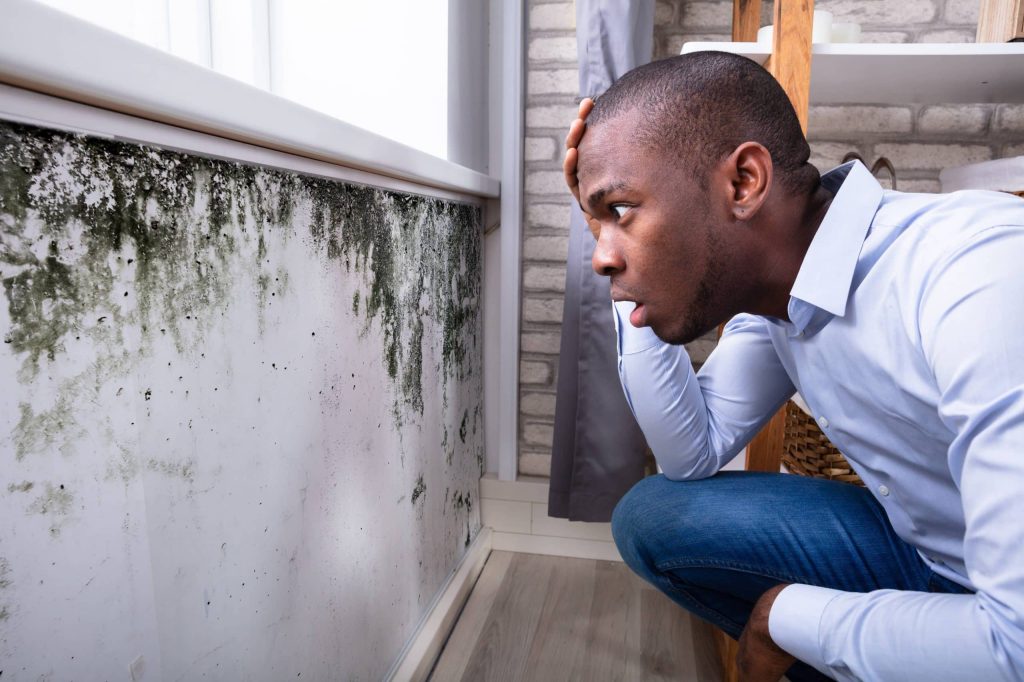Mold Prevention: Keeping Your Home Safe as Summer Transitions to Fall

As summer fades into fall, homeowners are often excited to welcome cooler temperatures and prepare for the holidays. However, the seasonal transition also brings the perfect conditions for mold growth, which thrives in damp and cool environments. Mold is more than just an unsightly nuisance; it can cause severe damage to your home and even lead to serious health issues if left untreated. At Affordable Restorations, we emphasize the importance of mold prevention during this season to protect both your property and your health.
In this blog post, we’ll discuss effective mold prevention strategies that can help you transition smoothly from summer to fall while keeping mold at bay.

Understanding the Risks: Why Fall Is Prime Time for Mold Growth
Mold spores are always present in the air, but they only become a problem when they land on a moist surface, which allows them to grow. During the fall, temperatures tend to cool down, and increased moisture from rainfall and damp leaves creates the ideal breeding ground for mold spores. Fall can bring higher levels of indoor humidity as windows close and homes become more sealed for warmth, further fostering conditions for mold growth.
The transition from summer to fall is also when homeowners often overlook outdoor areas like gutters, downspouts, and fallen leaves around the house. These areas trap moisture and can bring mold spores directly into your home. Mold prevention is not just about cleaning indoors—it also requires outdoor maintenance.
Exterior Mold Prevention: Focus on Outdoor Areas
When preventing mold, one of the first places to focus on is the exterior of your home. Since mold spores can travel through the air and enter your home via windows, doors, and ventilation systems, outdoor mold control is essential.

1. Clean Gutters and Downspouts Regularly
Gutters clogged with leaves and other debris trap water, creating a perfect environment for mold growth. If your gutters aren’t properly maintained, water can overflow and pool around the foundation of your home, leading to both water damage and mold issues. As part of your fall maintenance routine, clean your gutters thoroughly and ensure downspouts are directing water away from your home’s foundation.
2. Remove Fallen Leaves and Organic Debris
Organic debris like fallen leaves and branches can generate heat and moisture as they decay, providing mold spores with the nutrients they need to thrive. Regularly rake and remove leaves and other organic materials from around the exterior of your home, especially near walls, windows, and doors. This will help reduce the likelihood of mold spores entering your home.
3. Inspect Your Roof for Leaks
Fall is an excellent time to inspect your roof for any loose or damaged shingles. Even small leaks can lead to significant moisture buildup in your attic, which can quickly result in mold growth. Ensuring that your roof is in good condition will prevent moisture from getting into your home, particularly as fall brings more rain. A professional roof inspection is a great way to catch these issues early and avoid costly repairs later.
Interior Mold Prevention: Keep Moisture Under Control
While outdoor mold prevention is critical, much of the battle against mold occurs indoors. Fall is a time when windows are closed, and homes are more tightly sealed to keep in warmth, which can trap moisture inside. Preventing mold indoors requires diligent monitoring of humidity levels and managing any potential sources of water buildup.
1. Monitor Humidity Levels
Mold thrives in environments where the humidity exceeds 60%, so maintaining a comfortable level of humidity in your home is one of the best ways to prevent mold growth. Ideally, your indoor humidity should be between 30% and 50%. You can monitor humidity levels with a hygrometer, an inexpensive tool available at most home improvement stores. If your humidity levels are too high, consider investing in a dehumidifier to help reduce moisture in the air.

2. Address Plumbing Leaks Immediately
Leaks in plumbing systems are one of the most common causes of mold growth in the home. Fall is the perfect time to inspect your plumbing systems, especially since colder weather can cause pipes to crack. Check underneath sinks, around toilets, and near water heaters for any signs of leaks. If you discover a leak, address it immediately. Mold can begin to grow within 24-48 hours of exposure to moisture, so prompt action is key.
3. Ensure Proper Ventilation in High-Moisture Areas
Areas like bathrooms, kitchens, and laundry rooms are more prone to moisture buildup due to activities such as showering, cooking, and washing clothes. Make sure these areas are well-ventilated by using exhaust fans to remove excess moisture from the air. Opening windows periodically in these rooms can also improve air circulation and reduce the risk of mold. In the fall, as temperatures drop, it’s tempting to leave windows closed all the time, but periodically allowing fresh air to circulate can significantly reduce indoor moisture.
4. Clean and Dry Damp Areas Regularly
Bathrooms, basements, and laundry rooms are especially vulnerable to mold, so be diligent about keeping them dry. Wipe down wet surfaces like shower walls and bathroom tiles after use. If your basement tends to be damp, consider installing a moisture barrier or using moisture-resistant paint on the walls. Additionally, avoid piling wet towels or laundry on the floor—put them directly into the washer to prevent moisture from accumulating.
HVAC Maintenance for Mold Prevention
One of the most overlooked aspects of mold prevention is maintaining your HVAC system. Mold spores can accumulate in air ducts, filters, and evaporator coils if your system isn’t properly maintained, allowing mold to spread throughout your home when the system is running.

1. Replace HVAC Filters Regularly
A clean HVAC filter can significantly reduce the number of mold spores circulating through your home. Be sure to replace filters regularly, especially during the fall when systems are transitioning from air conditioning to heating. Consider using filters specifically designed to trap mold spores for added protection.
2. Clean and Maintain Air Ducts
Over time, dust and moisture can accumulate in your HVAC system’s air ducts, creating a prime environment for mold growth. Having your air ducts professionally cleaned once a year can prevent mold buildup and improve your system’s overall efficiency. Fall is an ideal time to schedule this maintenance, as it ensures your system is clean and ready for the colder months ahead.
3. Inspect Your Condensate Drain Line
Your HVAC system’s condensate drain line removes excess moisture from the air, and if it becomes clogged, it can cause water to pool around the unit, leading to mold growth. Check the drain line regularly to ensure it is functioning properly, and flush it with a mixture of water and bleach if necessary to prevent mold buildup.
Proactive Steps to Take for Long-Term Mold Prevention
While seasonal mold prevention strategies are essential, there are a few proactive measures you can take to protect your home from mold year-round:
- Use Mold-Resistant Products: When renovating or making improvements to your home, opt for mold-resistant building materials like drywall and paint. These products are specifically designed to resist moisture and prevent mold growth.
- Install a Sump Pump in Your Basement: If your home is prone to basement flooding or moisture buildup, installing a sump pump can help keep water from accumulating. This reduces the chances of mold developing in the basement.
- Mold-Resistant Insulation: In areas like the attic or crawl spaces, using mold-resistant insulation can help prevent mold from growing in areas that are often dark and prone to moisture buildup.
When to Call Affordable Restorations
Sometimes, despite your best efforts, mold growth can occur. If you notice significant mold buildup or suspect hidden mold in hard-to-reach areas like behind walls or in the attic, it’s important to contact a professional mold removal service. At Affordable Restorations, we offer comprehensive mold remediation services that can help you eliminate mold safely and effectively. Mold removal is a complex process, and attempting to tackle large mold infestations on your own can worsen the problem or put your health at risk.
For more information on our mold removal services, visit our Mold Removal Page, or if you’re dealing with a water-related emergency, learn more about our quick action water damage services here.
Protecting Your Home This Fall
Mold prevention requires vigilance, especially during the fall when conditions are ripe for mold growth. By following the tips outlined in this post, you can minimize the risk of mold developing in your home. However, should you encounter mold or water damage, acting quickly is crucial to prevent long-term damage and health risks.
At Affordable Restorations, we’re committed to helping you keep your home safe, dry, and mold-free. Contact us today to learn more about our mold prevention and removal services or to schedule an inspection. Visit our Restoration Services Page for more details.
Frequently Asked Questions Around Fall Season & Mold
| Why is fall a prime time for mold growth in my home? | During the fall, cooler temperatures and increased moisture from rain and fallen leaves create the ideal environment for mold spores to thrive. Homes are often sealed for warmth, trapping humidity indoors, which can foster mold growth. Additionally, outdoor areas like gutters and downspouts may become clogged with debris, causing water to pool around the house and leading to mold issues. |
| How can I prevent mold from growing indoors during the fall? | To prevent mold indoors, keep humidity levels between 30% and 50% using dehumidifiers and ensure proper ventilation in high-moisture areas like bathrooms and kitchens. Regularly check for plumbing leaks, wipe down wet surfaces, and ensure wet towels or laundry are not left lying around. Maintaining your HVAC system, including replacing filters and cleaning air ducts, also helps reduce the risk of mold growth. |
| What outdoor steps should I take to prevent mold during the fall? | Outdoor mold prevention involves clearing fallen leaves and organic debris away from your home, cleaning gutters and downspouts, and inspecting your roof for leaks. Ensuring proper water drainage around your home is essential to avoid moisture buildup that can lead to mold growth. Additionally, drying patio furniture and garden tools before storing them for the winter will help prevent mold in storage areas. |
| When should I call a professional for mold removal? | If you notice significant mold growth or suspect hidden mold in hard-to-reach areas like behind walls, in the attic, or around your HVAC system, it’s important to contact a professional. Large mold infestations can worsen if not handled properly, and DIY mold removal may expose you to health risks. Professional mold removal services ensure safe and effective treatment to prevent the mold from spreading further. |
